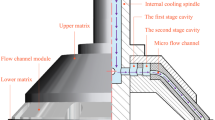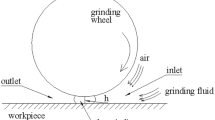Abstract
In view of the high specific removal energy, high heat generation rate, low heat transfer efficiency, and easy-to-produce local high-temperature and grinding burns, new macro-structured grinding wheel forms were proposed, namely, large spiral angle grooved grinding wheels (LSG-GW, β>85°) and large spiral angle flow disturbance grooved wheels (LSDG-GW). Considering the influence of wheel parameters, groove parameters, and process parameters, an analytical model of the airflow field in the wedge area and contact area of LSG-GW was established. Analytical model of gas–liquid two-phase flow field and theoretical model of convective heat transfer coefficient distribution in heat transfer channels were established. The results showed that increasing the groove width, groove depth, and the spiral angle can reduce the pressure of the flow field in the air barrier layer and make it easier for the grinding fluid to enter the grinding contact area. The LSDG-GW further reduces the grinding fluid back flow and side flow intensity, proving that the flow disturbance structure can bring in more grinding fluid into the grinding contact area. A theoretical model for the distribution of convective heat transfer coefficient in the grinding contact area was derived, and the analysis results proved that the flow disturbance structure can significantly improve the convective heat transfer coefficient in the grinding contact area. The LSDG-GW, as a new macro-surface-structured grinding wheel, has a very promising application in the high-efficiency and high-precision grinding process of difficult-to-machine alloy materials.




























Similar content being viewed by others
References
Denkena B, Grove T, Bremer I, Behrens L (2016) Design of bronze-bonded grinding wheel properties. CIRP Ann Manuf Technol 65:333–336. https://doi.org/10.1016/j.cirp.2016.04.096
Soo SL, Hood R, Aspinwall DK, Voice WE, Sage C (2011) Machinability and surface integrity of RR1000 nickel based superalloy. CIRP Ann Manuf Technol 60:89–92. https://doi.org/10.1016/j.cirp.2011.03.094
He B, Wei G, Ding S (2019) A survey of methods for detecting metallic grinding burn. Measurement 134:426–439. https://doi.org/10.1016/j.measurement.2018.10.093
Del R, Dix M, Tagliaferri F (2019) Grinding burn on hardened steel: characterization of onset-mechanisms by design of experiments. Int J Adv Manuf Technol 101:2889–2905. https://doi.org/10.1007/s00170-018-3156-6
Nadolny K, Kieraś S (2020) New approach for cooling and lubrication in dry machining on the example of internal cylindrical grinding of bearing rings. Sustain Mater Techno 24. https://doi.org/10.1016/j.susmat.2020.e00166
Srivastava A, Awale A, Vashista M, Yusufzai MZK (2020) Monitoring of thermal damages upon grinding of hardened steel using Barkhausen noise analysis. J Mech Sci Technol 34:2145–2151. https://doi.org/10.1007/s12206-020-0435-6
Krzysztof N, eweryn K (2020) Experimental studies on the centrifugal MQL-CCA method of applying coolant during the internal cylindrical grinding process. Materials 13. https://doi.org/10.3390/ma13102383
Simoes RP, Bianchi EC, Canarim RC (2014) Evaluation of different methods of cooling-lubrication in cylindrical grinding of advanced ceramic dip. Mater Res-IBERO-Am J 17:1201–1212. https://doi.org/10.1590/1516-1439.250713
Zhang YB, Li CH, Zhang Q, Jia DZ, Wang S, Zhang DK, Mao C (2016) Improvement of useful flow rate of grinding fluid with simulation schemes. Int J Adv Manuf Technol 84:2113–2126. https://doi.org/10.1007/s00170-015-7864-x
Xiao LF (2021) Simulation and experimental study on the grinding of electroplated grinding w-heels with sequential micro-grooved structure. Changsha University of Science & Technology. https://doi.org/10.26985/d.cnki.gcsjc.2021.000542
Jin T, Ma X, Hu H, Qu MN, Shang ZT (2022) Study on the inverse method of fluid convection heat transfer coefficient distribution in the contact zone of nickel-based high temperature alloy deep cut grinding. J Mech Eng 58:55–62. https://doi.org/10.3901/JME.2022.15.055
Kadivar M (2020) Numerical model for heat transfer in dry and wet grinding based on the finite difference method and jet cooling. J Therm Sci Eng Appl 12. https://doi.org/10.1115/1.4045676
Daneshi A, Muller K, Azarhoushang B (2018) Cylindrical plunge grinding of twist free surfaces by structured wheels. Precis Eng 51:481–489. https://doi.org/10.1016/j.precisioneng.2017.10.003
Mandal B, Singh R, Das S, Banerjee S (2011) Improving grinding performance by controlling air flow around a grinding wheel. Int J Mach Tool Manu 51:670–676. https://doi.org/10.1016/j.ijmachtools.2011.06.003
Kaczmarek J (2008) The effect of abrasive cutting on the temperature of grinding wheel and its relative efficiency. Arch Civ Mech Eng 8:81–91. https://doi.org/10.1016/S1644-9665(12)60195-2
Zhang JZ, Tan XM, Liu B, Zhu XD (2013) Investigation for convective heat transfer on grinding work-piece surface subjected to an impinging jet. Appl Therm Eng 51:653–661. https://doi.org/10.1016/j.applthermaleng.2012.10.011
Mohamed AO, Bauer R, Warkentin A (2016) Warkentin. Uncut chip thickness and coolant delivery effects on the performance of circumferentially grooved grinding wheels. Int J Adv Manu-f Technol 85:1429–1438. https://doi.org/10.1007/s00170-015-8062-6
Peng KL, Lu P, Lin FH, Jin T, Bao WC, Xie GZ, Shang ZT (2021) Convective cooling and heat partitioning to grinding chips in high speed grinding of a nickel based superalloy. J Mech Sci Technol 35:2755–2767. https://doi.org/10.1007/s12206-021-0545-9
Yi J, Jin T, Zhou W, Deng ZH (2020) Theoretical and experimental analysis of temperature distribution during full tooth grooved form grinding. J Manuf Process 58:101–115. https://doi.org/10.1016/j.jmapro.2020.08.011
Yang M, Li CH, Luo L, Li RZ, Long YZ (2021) Predictive model of convective heat transfer coefficient in bone micro-grinding using nanofluid aerosol cooling. Int Commun. Heat Mass Transf 125. https://doi.org/10.1016/j.icheatmasstransfer.2021.105317
Zhang JC, Wu WT, Li CH, Yang M, Zhang YB, Jia DZ, Hou YL, Li RZ, Cao HJ, Ali HM (2020) Convective heat transfer coefficient model under nanofluid minimum quantity lubrication coupled with cryogenic air grinding Ti–6Al–4V. Int J Pr Eng Man-GT 8:1113–1135. https://doi.org/10.1007/s40684-020-00268-6
Riebel A, Bauer R, Warkentin A (2020) Investigation into the effect of wheel groove depth and width on grinding performance in creep-feed grinding. Int J Adv Manuf Technol 106:4401–4409. https://doi.org/10.1007/s00170-020-04933-7
Shen B, Shih AJ, Xiao GX (2011) A heat transfer model based on finite difference method for grinding. J Manuf Sci E-T ASME 133. https://doi.org/10.1115/1.4003947
Funding
This work was supported by the Natural Science Foundation of Shandong Province (ZR2022ME192), the National Natural Science Foundation of China (51605240), and the Taishan Scholar Project of Shandong Province (ts201511038).
Author information
Authors and Affiliations
Contributions
All authors contributed to the study conception and design. Material preparation was performed by Mingzhe Mao and Jingliang Jiang, data collection was performed by Shibo Liu and Dexiang Wang, and analysis was performed by Mingzhe Mao and Shufeng Sun. The first draft of the manuscript was written by Mingzhe Mao, and all authors commented on previous versions of the manuscript. All authors read and approved the final manuscript.
Corresponding author
Ethics declarations
Competing interests
The authors declare no competing interests.
Additional information
Publisher’s Note
Springer Nature remains neutral with regard to jurisdictional claims in published maps and institutional affiliations.
Rights and permissions
Springer Nature or its licensor (e.g. a society or other partner) holds exclusive rights to this article under a publishing agreement with the author(s) or other rightsholder(s); author self-archiving of the accepted manuscript version of this article is solely governed by the terms of such publishing agreement and applicable law.
About this article
Cite this article
Mao, M., Liu, S., Jiang, J. et al. Study on flow field and convective heat transfer characteristics in grinding zone of large spiral angle flow disturbance grooved wheel. Int J Adv Manuf Technol 129, 39–63 (2023). https://doi.org/10.1007/s00170-023-12226-y
Received:
Accepted:
Published:
Issue Date:
DOI: https://doi.org/10.1007/s00170-023-12226-y




